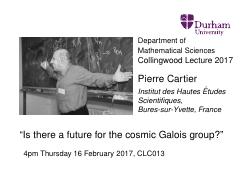The 2016/17 Collingwood Lecture
Professor Pierre Cartier (Institut des Hautes Etudes Scientifiques, Paris)
"Is there a future for the cosmic Galois group?"
16 February 2017, 4.00pm, CLC013
Professor Cartier studied at the École Normale Supérieure in Paris from 1952 to 1954 and obtained his doctorate from the Université de Paris in 1958, with a thesis entitled `Derivations and Divisors in Algebraic Geometry'. By 1955, he had become a full member of the Bourbaki group (Bourbaki is the pseudonym of a group of (mainly) French mathematicians who publish an authoritative account of contemporary mathematics). He was appointed Professor in the Faculty of Science at Strasbourg in 1961, remaining there until he moved to the Institut des Hautes Études Scientifiques at Bures-sur-Yvette ten years later. In addition to this post he was director of research at the Centre National de la Recherche Scientifique from 1974. In 1982 he left the Institut des Hautes Études Scientifiques becoming a professor at the École Polytechnique (1982-88) and at the École Normale Supérieure from 1988. Professor Cartier has written papers on a broad range of mathematical topics including algebraic geometry, number theory, group theory, probability, and mathematical physics. He was awarded the Ampère Prize of the French Academy of Sciences in 1979.
Abstract: About twenty years ago, Pierre Cartier observed a similitude between the renormalization group in physics - in the construction given by Alain Connes and Dirk Kreimer - and the Grothendieck Teichmuller group in arithmetic geometry. The initial guess was a little too optimistic, based on numerical calculations by Broadhurst and Kreimer. A revised version suggests a connection between the Galois theory of transcendental numbers (as envisionned by Grothendieck) and a possible new kind of symmetry group in high energy physics: the `cosmic Galois group'. This direction has been developed by Francis Brown, giving explicit `superselection rules'. Much more is expected.
